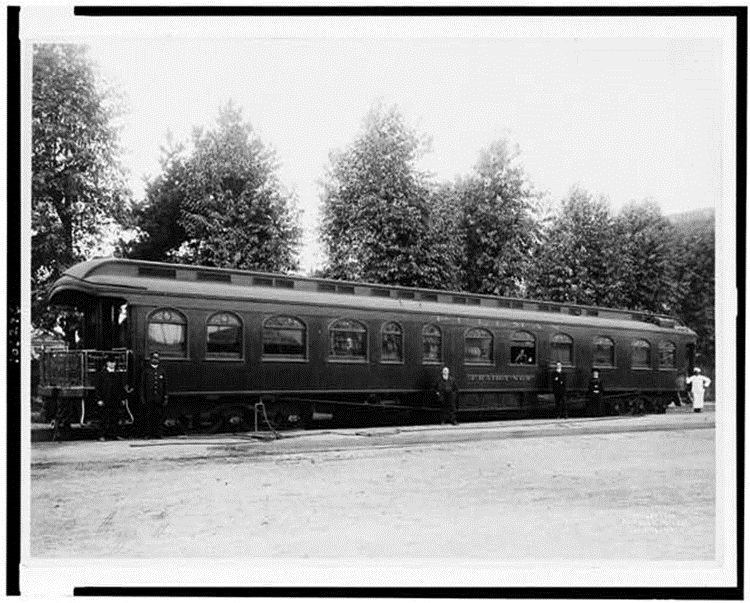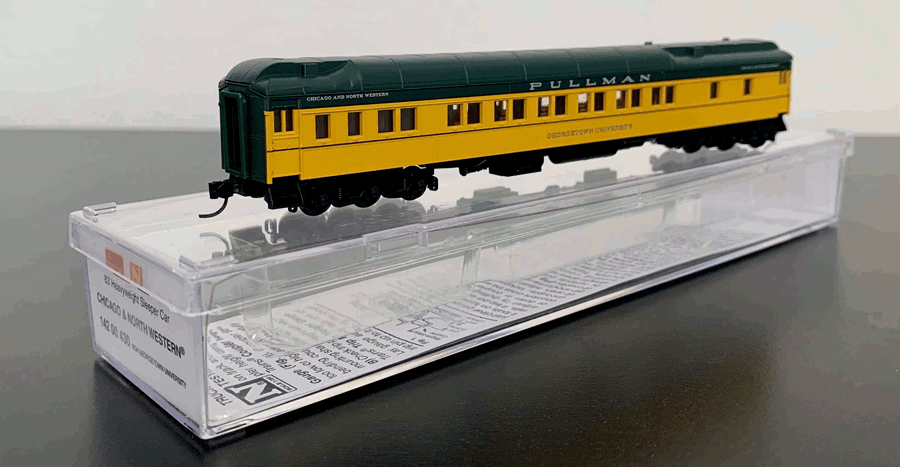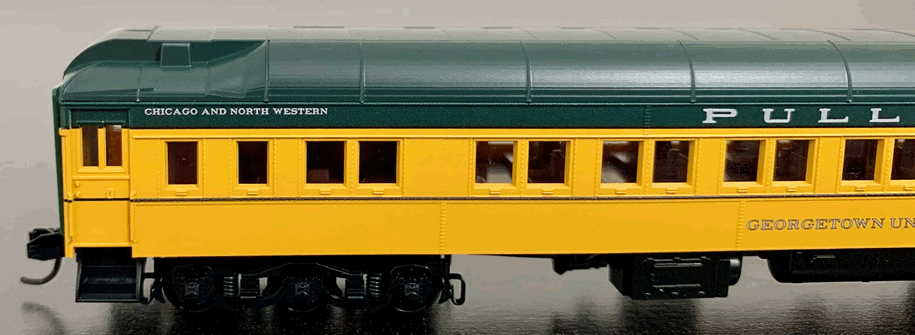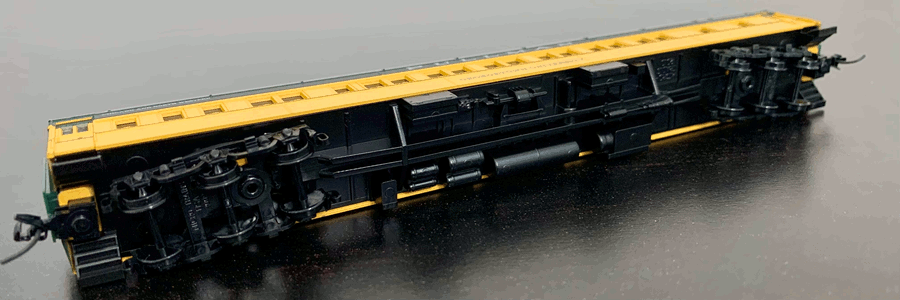Micro-Trains Line 83-Foot Pullman Heavyweight 12-1 Sleeper
Published: 2022-02-28 - By: CNW400
Last updated on: 2022-03-01
Last updated on: 2022-03-01
visibility: Public - Headline

Over the last several months, Micro-Trains Line has released a multitude of N scale models into their heavyweight passenger car collection. Each release features a North American body style reminiscent of the days when the railroads dominated the passenger transportation system. This review is focusing on the Chicago & North Western Pullman heavyweight passenger car series.
 My review includes observations of Micro-Trains Line 142-00-430 – Pullman 83-foot Chicago & North Western 12-1 sleeper car Georgetown University.
My review includes observations of Micro-Trains Line 142-00-430 – Pullman 83-foot Chicago & North Western 12-1 sleeper car Georgetown University.
In April of 1943 the federal courts ruled that Pullman, Inc. did hold a monopoly in the manufacturing and operating of passenger cars. Pullman, Inc. was ordered in 1944 to divest itself from either the operating or manufacturing business. Pullman, Inc. decided to sell its operating business. In June of 1947, a consortium of 57 railroad companies purchased the sleeping car business for a reported $74 million. The sleeper cars were now owned, operated and maintained by the railroads. The Pullman-Standard Car Manufacturing Company continued to manufacture passenger cars until 1982 with their release of the Amtrak Superliner cars. Bombardier Transportation of Germany acquired the assets and railcar designs of both Pullman-Standard and the Budd Company in 1987.
The 12-1 sleeper car was a mainstay for the Pullman Company, easily the most prevalent design of the Pullman fleet. Pullman was managing 8,011 railcars by 1931 - 3,957 of these were 12-1 sleepers.
The heavyweight railcars - built between 1907 and 1931 - had riveted carbon steel construction, 36” six-wheel trucks, steam heat with electric lighting, arched roofs, and concrete floors. The surprise discovery of 2-inch poured concrete floors served several functions: better sound insulation from the rail tracks, better weight distribution for a smoother cushioned ride, better transfer of radiant heat and solid construction in case of a rail accident.
Commonly painted a dark Pullman green (dark olive green) with a black roof and gold Pullman name on the letterboard before the take-over of 1947, the 12-section / 1-drawing room sleeper featured an open section with fold-down upper berths and folding seat lower berths and a single drawing room. A drawing room is a large, enclosed area with three berths, a washbasin and private toilet facilities – typically occupied by families.

Quick Sketch of Pullman 12-1 Sleeper Car
A key spotting feature for the 12-1 sleeper are the six pairs of equal sized windows that run along the center of the car. Other characteristics include the unique clerestory roof design that was replaced with sheet metal ventilators along the top ridges of the car in the 1930’s to draw fresh air into the car. Also, two sizable restrooms were located at either end of the railcar – the men’s washroom which includes a smoking lounge near one end and a women’s bathroom with a vanity table situated at the other end of the sleeper car.

Pullman Car CRAIG-Y-NOS with Clerestory Roof Design (1904)
Library of Congress Prints and Photographs Division, Washington, D.C. 20540 USA – Public Domain
Marceau, T. C., photographer. (1904) Pullman car CRAIG-Y-NOS, with its personnel & members of the Adelina Patti group standing outside
1904. [Photograph] Retrieved from the Library of Congress, https://www.loc.gov/item/92520375/
The heavyweight cars were modernized with mechanical air-conditioning starting in the mid-1930's with visible rooftop ducts. Not all Pullman sleeper cars looked the same – with rebuilding and reconfiguration of design plans many variations of 12-1 sleeper cars rode the rails. There were four different types of trucks fitted on the Pullman sleeper (2410A, 2411, 242 and 242A) and five varieties of air conditioning systems were made available for the railcars.
Micro-Trains Line has identified the Georgetown Pullman car as a 12-1 sleeper...they are WRONG. This model has an identity crisis --- the Georgetown car is actually a 12-2 sleeper car...close but still erroneous.
The Georgetown sleeper did begin its rail service as a 12-1 car. Initially built for the Pennsylvania Railroad in August 1917 (Lot 4515 – Plan 2410F) with Tuscan Red paint and christened with the name 'Reybold’. In the 1930’s, Pullman rebuilt and modernized existing sleeper cars to support new layout designs and accommodations.
The first series of cars were rebuilt to Pullman Plan 4042 (10 Section – 2 Bedroom – 1 Compartment) and repainted dark Pullman green with black roof and undercarriage. These sleepers were assigned College-series names and serviced the routes near their namesake schools. The Pullman name ran across the letterboard in large gold Roman letters while the college name was stenciled on the center of the car beneath the windows. Several 12-1 cars were also rebuilt to Pullman Plan 4046 (12 Section – 2 Double Bedroom) with the same paint scheme and appointed to either the University-series or White-series name fleet. The Reybold 12-1 sleeper car was rebuilt in June 1936 to Plan 4046 (12-2) with ice activated air conditioning and renamed Georgetown University. Chicago & North Western acquired the Georgetown in December 1948 with the divestiture of the Pullman Company and was repainted green and yellow with the Pullman name scrolled across the letterboard in gold letters and Chicago & North Western in a smaller font adjacent to the vestibule doors. The Georgetown retired from revenue service in March 1965 and was reassigned to the Maintenance of Way Department as road number X-301025.

Model with box
The familiar Chicago & North Western green and yellow paint job is clean, bold, and even along the entire injection molded plastic model. Rivet panel lines are straight and sharp. The lettering is neat and clear and there are no tiny characters that require magnification. The placement and size of the printing are similar to a color prototype image I found – but the font and coloring are inaccurate. The prototype photo displays gold Roman-style lettering with a black outline for both the Pullman and C&NW names in the green band across the top portion of the car. The Georgetown University name is a silvery-white hue centered below the windows on the yellow panels on the real-life sleeper car. Micro-Trains Line totally flipped the color combinations with white letters up top and gold letters for the car name.

Crisp and Neat Lettering but Incorrect Color Combinations and Window Configurations
Furthermore, the sleeper car side window configurations and passenger door windows on the Micro-Trains model do not match the Georgetown University photograph. For instance, the prototype car features a single lite window on the passenger door with rounded corners – unlike the rectangular double lite window with straight corners on the Micro-Trains car. The Micro-Trains model also displays rather unimpressive, flat molded handrails on each side of the doors. Some points are scored with the simple brown plastic seats visible through the six double-windows in the center of the car.

End Diaphragm
Each end features a stiff diaphragm and rivets steel panels. The roof of the sleeper car has the correct rounded 8-section panel composition with exposed vents. Although located in the proper areas of the roof (three circles and two squares), these molded vents and air conditioning ducts are highly undetailed. Moreover, the roof is painted the wrong color – prototype images show the Georgetown University roof in the Pullman black color scheme.

Inaccurate Molded Roof Color
The black underside features a non-steam ejector air conditioning system with a full complement of detail with a compressor, holding tanks, reservoirs, battery boxes and generator. The air conditioning system on the prototype appears to have modernized as the configuration in the photo does not match the Micro-Trains model. But I am impressed with the highly sophisticated underbody design presented by Micro-Trains. The heavyweight sleeper car runs on black plastic six-wheel passenger car trucks and is equipped with proper height body-mounted Magne-Matic Knuckle couplers.


Pullman Sleeper Car with Non-Steam Ejector Air Conditioning
The car weighs about 1.3 ounces and is 6.25 inches in length. While this weight is a tad light according to the National Model Railroad Association (which are 1.4 - 1.5 ounces), I found it a good running car on Kato Unitrack with no issues around curves or through turnouts at low and medium speeds while coupled in middle of a seven-passenger car train. A minimum 14” radius is recommended for operation.
As usual, there are two-sides with purchasing Micro-Trains Line models. On one hand you receive a good-looking, smooth-running car fitted with the best N scale coupling system. Quality built, slick paint and sharp lettering.
On the other hand, Micro-Trains is not the choice for the prototype modeler. Micro-Trains Line tends to use older molds and tooling to represent models that are “close enough” to actual railroad equipment. It is placed upon the modeler to make any post-purchase modifications to better represent true-life railcars. This sleeper car is the perfect example – a superbly constructed model with clean, crisp colors and excellent performance. But misrepresented as a 12-1 sleeper (the true Georgetown was a 12-2), several inaccurate color choices, incorrect air conditioning system and underwhelming detail parts.
Again ‘close enough’ for those who do not know better or do not care.
To see a list of all cars in this series, CLICK HERE.
Road Names and Pricing
 My review includes observations of Micro-Trains Line 142-00-430 – Pullman 83-foot Chicago & North Western 12-1 sleeper car Georgetown University.
My review includes observations of Micro-Trains Line 142-00-430 – Pullman 83-foot Chicago & North Western 12-1 sleeper car Georgetown University.
Prototype History
George Pullman incorporated the Pullman Palace Car Company in 1867 with its first plants in Detroit and New York State. The Pullman Company manufactured and operated luxury sleeping cars on most of the United States railroads until the mid-1940’s. In 1940 an anti-trust complaint was filed against Pullman, Inc. siting unfair competition by monopoly. It was alleged that Pullman, Inc. restricted the development of lightweight sleeping cars by others and threatened to remove all Pullman owed cars from service if the railroads pursued other resources.In April of 1943 the federal courts ruled that Pullman, Inc. did hold a monopoly in the manufacturing and operating of passenger cars. Pullman, Inc. was ordered in 1944 to divest itself from either the operating or manufacturing business. Pullman, Inc. decided to sell its operating business. In June of 1947, a consortium of 57 railroad companies purchased the sleeping car business for a reported $74 million. The sleeper cars were now owned, operated and maintained by the railroads. The Pullman-Standard Car Manufacturing Company continued to manufacture passenger cars until 1982 with their release of the Amtrak Superliner cars. Bombardier Transportation of Germany acquired the assets and railcar designs of both Pullman-Standard and the Budd Company in 1987.
The 12-1 sleeper car was a mainstay for the Pullman Company, easily the most prevalent design of the Pullman fleet. Pullman was managing 8,011 railcars by 1931 - 3,957 of these were 12-1 sleepers.
The heavyweight railcars - built between 1907 and 1931 - had riveted carbon steel construction, 36” six-wheel trucks, steam heat with electric lighting, arched roofs, and concrete floors. The surprise discovery of 2-inch poured concrete floors served several functions: better sound insulation from the rail tracks, better weight distribution for a smoother cushioned ride, better transfer of radiant heat and solid construction in case of a rail accident.
Commonly painted a dark Pullman green (dark olive green) with a black roof and gold Pullman name on the letterboard before the take-over of 1947, the 12-section / 1-drawing room sleeper featured an open section with fold-down upper berths and folding seat lower berths and a single drawing room. A drawing room is a large, enclosed area with three berths, a washbasin and private toilet facilities – typically occupied by families.

A key spotting feature for the 12-1 sleeper are the six pairs of equal sized windows that run along the center of the car. Other characteristics include the unique clerestory roof design that was replaced with sheet metal ventilators along the top ridges of the car in the 1930’s to draw fresh air into the car. Also, two sizable restrooms were located at either end of the railcar – the men’s washroom which includes a smoking lounge near one end and a women’s bathroom with a vanity table situated at the other end of the sleeper car.

Library of Congress Prints and Photographs Division, Washington, D.C. 20540 USA – Public Domain
Marceau, T. C., photographer. (1904) Pullman car CRAIG-Y-NOS, with its personnel & members of the Adelina Patti group standing outside
1904. [Photograph] Retrieved from the Library of Congress, https://www.loc.gov/item/92520375/
The heavyweight cars were modernized with mechanical air-conditioning starting in the mid-1930's with visible rooftop ducts. Not all Pullman sleeper cars looked the same – with rebuilding and reconfiguration of design plans many variations of 12-1 sleeper cars rode the rails. There were four different types of trucks fitted on the Pullman sleeper (2410A, 2411, 242 and 242A) and five varieties of air conditioning systems were made available for the railcars.
Micro-Trains Line has identified the Georgetown Pullman car as a 12-1 sleeper...they are WRONG. This model has an identity crisis --- the Georgetown car is actually a 12-2 sleeper car...close but still erroneous.
The Georgetown sleeper did begin its rail service as a 12-1 car. Initially built for the Pennsylvania Railroad in August 1917 (Lot 4515 – Plan 2410F) with Tuscan Red paint and christened with the name 'Reybold’. In the 1930’s, Pullman rebuilt and modernized existing sleeper cars to support new layout designs and accommodations.
The first series of cars were rebuilt to Pullman Plan 4042 (10 Section – 2 Bedroom – 1 Compartment) and repainted dark Pullman green with black roof and undercarriage. These sleepers were assigned College-series names and serviced the routes near their namesake schools. The Pullman name ran across the letterboard in large gold Roman letters while the college name was stenciled on the center of the car beneath the windows. Several 12-1 cars were also rebuilt to Pullman Plan 4046 (12 Section – 2 Double Bedroom) with the same paint scheme and appointed to either the University-series or White-series name fleet. The Reybold 12-1 sleeper car was rebuilt in June 1936 to Plan 4046 (12-2) with ice activated air conditioning and renamed Georgetown University. Chicago & North Western acquired the Georgetown in December 1948 with the divestiture of the Pullman Company and was repainted green and yellow with the Pullman name scrolled across the letterboard in gold letters and Chicago & North Western in a smaller font adjacent to the vestibule doors. The Georgetown retired from revenue service in March 1965 and was reassigned to the Maintenance of Way Department as road number X-301025.
The Model
The Micro-Trains sleeper car comes packaged in a clear plastic jewel case with a slip-off cover and a one-piece plastic cradle to cushion the model. The model information is clearly labeled on the end of the case for ease to locate when in storage. A thin, rigid plastic sheet was propped on the exposed side of the car to protect the print job and windows from scratches.
The familiar Chicago & North Western green and yellow paint job is clean, bold, and even along the entire injection molded plastic model. Rivet panel lines are straight and sharp. The lettering is neat and clear and there are no tiny characters that require magnification. The placement and size of the printing are similar to a color prototype image I found – but the font and coloring are inaccurate. The prototype photo displays gold Roman-style lettering with a black outline for both the Pullman and C&NW names in the green band across the top portion of the car. The Georgetown University name is a silvery-white hue centered below the windows on the yellow panels on the real-life sleeper car. Micro-Trains Line totally flipped the color combinations with white letters up top and gold letters for the car name.

Furthermore, the sleeper car side window configurations and passenger door windows on the Micro-Trains model do not match the Georgetown University photograph. For instance, the prototype car features a single lite window on the passenger door with rounded corners – unlike the rectangular double lite window with straight corners on the Micro-Trains car. The Micro-Trains model also displays rather unimpressive, flat molded handrails on each side of the doors. Some points are scored with the simple brown plastic seats visible through the six double-windows in the center of the car.

Each end features a stiff diaphragm and rivets steel panels. The roof of the sleeper car has the correct rounded 8-section panel composition with exposed vents. Although located in the proper areas of the roof (three circles and two squares), these molded vents and air conditioning ducts are highly undetailed. Moreover, the roof is painted the wrong color – prototype images show the Georgetown University roof in the Pullman black color scheme.

The black underside features a non-steam ejector air conditioning system with a full complement of detail with a compressor, holding tanks, reservoirs, battery boxes and generator. The air conditioning system on the prototype appears to have modernized as the configuration in the photo does not match the Micro-Trains model. But I am impressed with the highly sophisticated underbody design presented by Micro-Trains. The heavyweight sleeper car runs on black plastic six-wheel passenger car trucks and is equipped with proper height body-mounted Magne-Matic Knuckle couplers.


The car weighs about 1.3 ounces and is 6.25 inches in length. While this weight is a tad light according to the National Model Railroad Association (which are 1.4 - 1.5 ounces), I found it a good running car on Kato Unitrack with no issues around curves or through turnouts at low and medium speeds while coupled in middle of a seven-passenger car train. A minimum 14” radius is recommended for operation.
As usual, there are two-sides with purchasing Micro-Trains Line models. On one hand you receive a good-looking, smooth-running car fitted with the best N scale coupling system. Quality built, slick paint and sharp lettering.
On the other hand, Micro-Trains is not the choice for the prototype modeler. Micro-Trains Line tends to use older molds and tooling to represent models that are “close enough” to actual railroad equipment. It is placed upon the modeler to make any post-purchase modifications to better represent true-life railcars. This sleeper car is the perfect example – a superbly constructed model with clean, crisp colors and excellent performance. But misrepresented as a 12-1 sleeper (the true Georgetown was a 12-2), several inaccurate color choices, incorrect air conditioning system and underwhelming detail parts.
Again ‘close enough’ for those who do not know better or do not care.
To see a list of all cars in this series, CLICK HERE.

